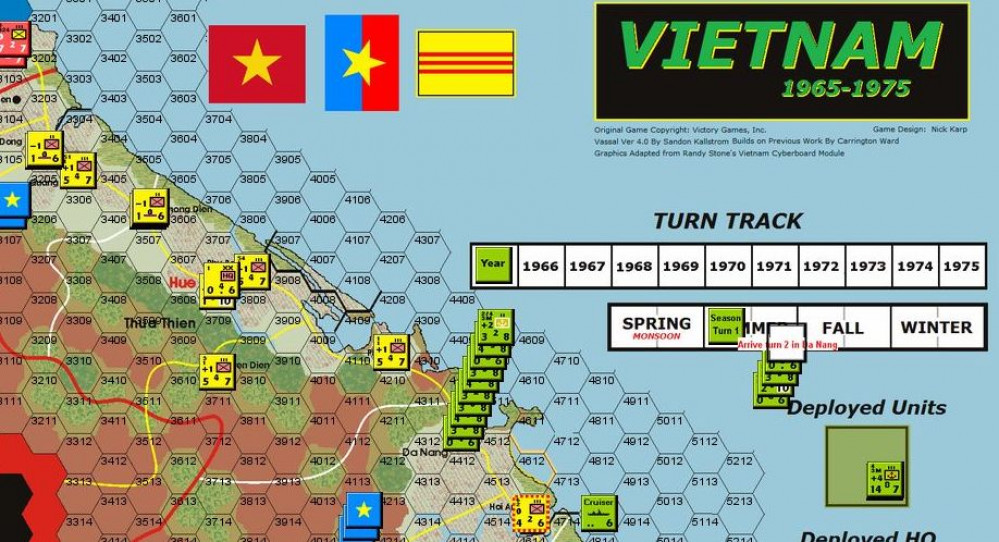
Vietnam 1965-75 Hex & Counter (Victory Games)
Battle for I Corps - Turn 2
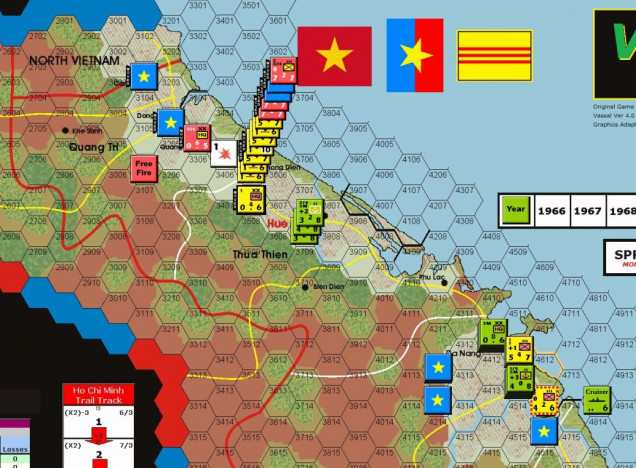 Turn 2 action started in the north with a VC/NVN thrust towards Hue. ARVN forces moved to reinforce, supported by US airpower. A Free Fire zone was declared by the US in this northern province to maximize their support at the expense of Victory points (arty and air points are halved in a non-free fire province, NVN gains 2 VP for each free fire zone). Interdiction was placed on the road to the north of the battle, but it was fruitless as the NLF forces overwhelmed the town of Phong Dien and pushed the ARVN troops back towards Hue.
Turn 2 action started in the north with a VC/NVN thrust towards Hue. ARVN forces moved to reinforce, supported by US airpower. A Free Fire zone was declared by the US in this northern province to maximize their support at the expense of Victory points (arty and air points are halved in a non-free fire province, NVN gains 2 VP for each free fire zone). Interdiction was placed on the road to the north of the battle, but it was fruitless as the NLF forces overwhelmed the town of Phong Dien and pushed the ARVN troops back towards Hue.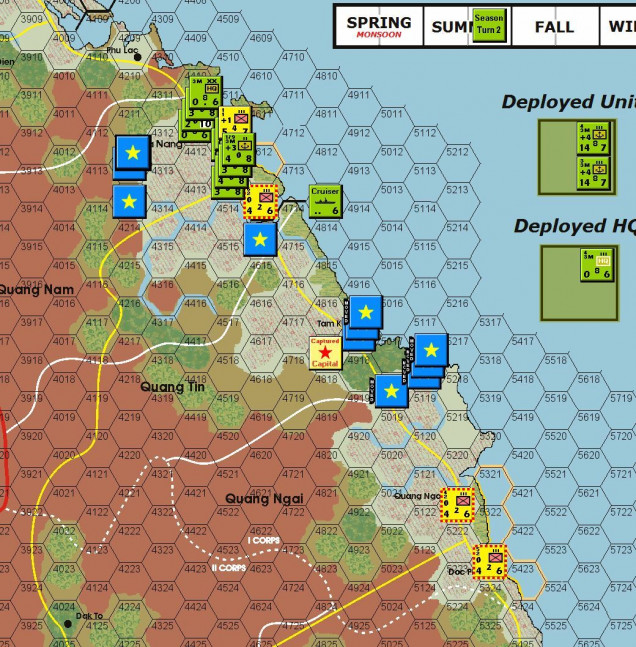 The NLF player continued the attacks in the south, focusing on the ineffective 2nd ARVN forces. These units were forced to retreat or disperse even with some limited US air power in support.
The NLF player continued the attacks in the south, focusing on the ineffective 2nd ARVN forces. These units were forced to retreat or disperse even with some limited US air power in support.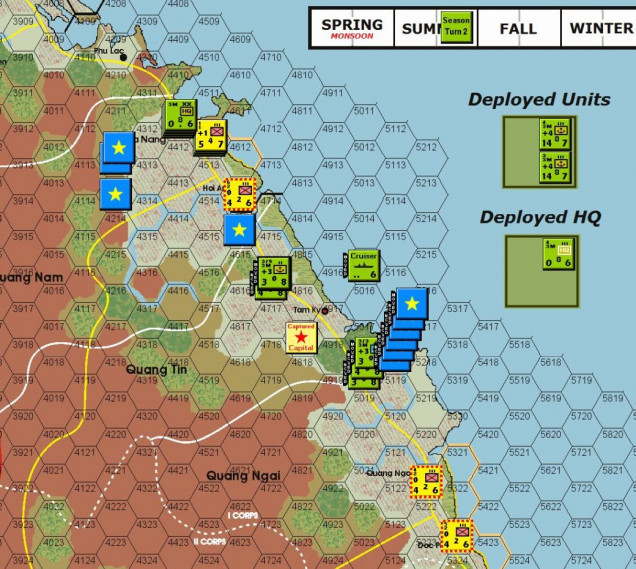 Elements of the 3rd Marines were activated as defensive reserves using airmobile points, and quickly got into contact with the attacking forces to start a push back. With a cruiser also moving to support, the US forces regained the lost towns, forcing the VC units into retreat. Follow-up attacks were poorly executed (dice rolls!!) and the VC forces could not be persuaded to leave the point-scoring cultivated hexes.
Elements of the 3rd Marines were activated as defensive reserves using airmobile points, and quickly got into contact with the attacking forces to start a push back. With a cruiser also moving to support, the US forces regained the lost towns, forcing the VC units into retreat. Follow-up attacks were poorly executed (dice rolls!!) and the VC forces could not be persuaded to leave the point-scoring cultivated hexes.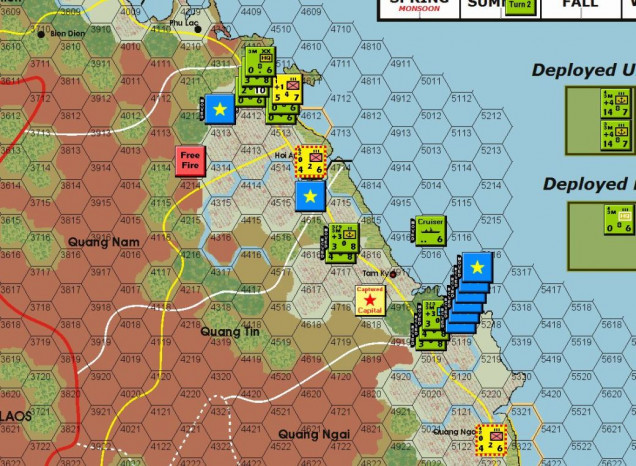 Final skirmishes in Quang Nam province were decisive for the US forces, but at the expense of heavy losses and use of support and reinforcements that still gained the NLF crucial victory points.
Final skirmishes in Quang Nam province were decisive for the US forces, but at the expense of heavy losses and use of support and reinforcements that still gained the NLF crucial victory points.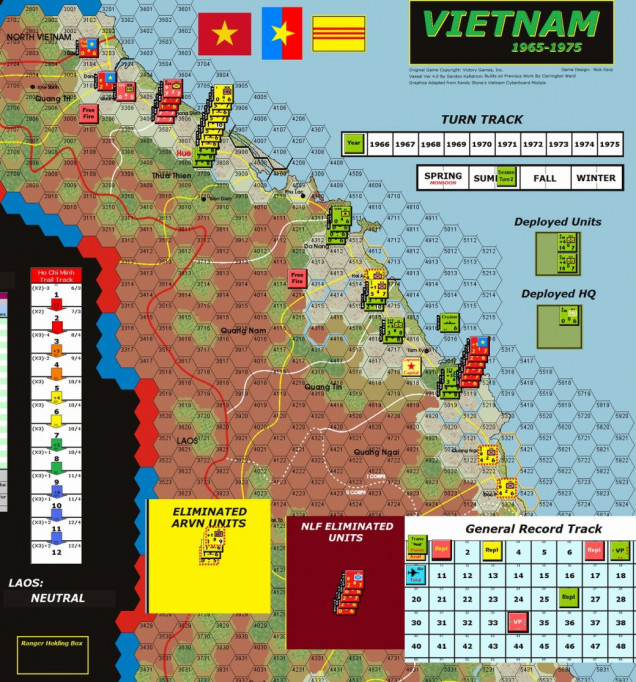 With the action over and the dust settled, the NLF player scored a narrow win with a final score of 87 (1 point past a draw!!). Early gains in the north could not be retaken by the US forces without putting critical towns at risk in the central area of the Corps. Limited US forces had to be everywhere in the face of dispersed NLF attacks with only tepid support from the ARVN forces.
With the action over and the dust settled, the NLF player scored a narrow win with a final score of 87 (1 point past a draw!!). Early gains in the north could not be retaken by the US forces without putting critical towns at risk in the central area of the Corps. Limited US forces had to be everywhere in the face of dispersed NLF attacks with only tepid support from the ARVN forces.This scenario captured the spirit of the Tet Offensive. Having not really been challenged in the population centres to this point, the US forces were caught flat-footed in the wake of numerous and widespread NLF attacks. On reflection, initial attacks may have been better made with the US troops instead of the ARVN forces for a better punch and a chance at regaining some territory. Played a little too passive and did not have the forces at hand to turn the tide once the NLF wave started to roll. The use of Free Fire zones and widespread support stemmed further advances, but gave away valuable Victory Points and handcuffed the US ability to act offensively.
The scenarios in Vietnam 1965-75 are meant to give a taste of different aspects of the game found in a full campaign. Aggression needs to be met with aggression during an offensive and the US player needs to take greater risks to keep momentum. In a campaign, an offensive has great impacts on US morale back home which curtails support available in subsequent turns. The NLF player may lose some battles, but this scenario shows how an offensive can go a long way towards winning a war.

































![TerrainFest 2024! Build Terrain With OnTableTop & Win A £300 Prize [Extended!]](https://images.beastsofwar.com/2024/10/TerrainFEST-2024-Social-Media-Post-Square-225-127.jpg)








































@donimator – Epic! I was wondering where this project had gone to. Not only a war that doesn’t get enough attention among historical players, but I Corps, which is my “favorite” part of the conflict. Interesting how the battle seems to have started in the northernmost provinces like Quang Tri (Hue) and then spread southward. So much of your battle report sounded like the real challenges faced by both sides … American units having to be everywhere at once because of a widespread failure (or at least under-performance) of ARVN units, and collateral damage being a limiting factor to what… Read more »
Thanks @oriskany – slower posting than I wanted for this one from waiting for images showing my opponent’s hidden units, holidays, and good ‘ol inertia. You have my respect for the quality of your battle reports. It is an art and a skill and I pick up a lot by following yours! As mentioned, the scenarios in this game don’t skew towards historical accuracy as much as they highlight aspects of the game for campaign play. The US forces in this one, I believe were close to historical composition and location. But the NLF player gets free rein on deployment,… Read more »